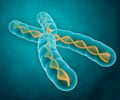A thorough genetic investigation was done based on the case of a child suffering from the Nivelon-Nivelon-Mabille syndrome, a complex condition of sexual development disorder.

Girl or boy: not so straight-forward Sexual ambiguities are relatively frequent congenital conditions. In many cases, despite considerable progress in understanding the genetic factors involved in gonadal differentiation, the causative mutation remains unknown. Identifying them is therefore crucial to carry out genetic testing, reason why, for many years, researchers have been collecting as much data as possible on the genome of patients affected by various forms of disorder of sex development.
A specific genetic mutation Within this context, geneticists at UNIGE have had the opportunity to focus on the case of a child, a genetically XY little girl presenting a disorder of sex development, with testicular dysgenesis and chondrodysplasia, an illness which disrupts skeletal growth and alters its structure and shape. In this child, they were able to determine the cellular elements at work in gonadal formation, and in turn to identify the genetics involved. Using the patient's DNA sequencing data, the researchers identified a mutation in the HHAT gene, a gene largely expressed in human organs during foetal development, including in the testes and ovaries during sexual development. HHAT function is to encode an enzyme essential to the proper functioning of a family of signalling molecules known as Hedgehog, which play a key role in embryonic development. Reduced Hedgehog functional performance results in the disorders suffered by the patient, which affect not only sexual development, but also growth and skeletal development.
A hypothesis confirmed in vivo To confirm their discovery, geneticists then developed in vitro tests to show that the mutation interferes with a specific activity of the HHAT gene. They also foundthat mutant mice with the non-functioning HHAT gene presented testicular dysgenesis and other skeletal, neuronal and growth development problems which were very similar to those identified in the young patient. In developing testes, the HHAT gene plays a role in the formation of the testis cords itself and in the differentiation of foetal Leydig cells; the latter, which produce androgens which contribute to the masculinsation of the foetus, and later of the individual, were absent in the testes of mutant mice. Generally speaking, these results shed new light on the mechanisms of action of the Hedgehog proteins and provide the first clinical evidence of the essential role played by these proteins in human testicular organogenesis and embryonic development.
"Using this patient's case as a starting point, we were able to trace the genetic course up to the cause of this sexual and other development disorders", stresses Serge Nef. "Identifying the gene and mechanism at stake allows us to pinpoint the exact diagnosis, develop genetic tests and provide better treatment to patients suffering from this syndrome". If, for the time being, we cannot cure patients suffering from a disorder of sex development and its consequences, an early diagnosis in a child's life will enable us to predict how they will develop later and to propose appropriate therapeutic strategies.
Source-Eurekalert










